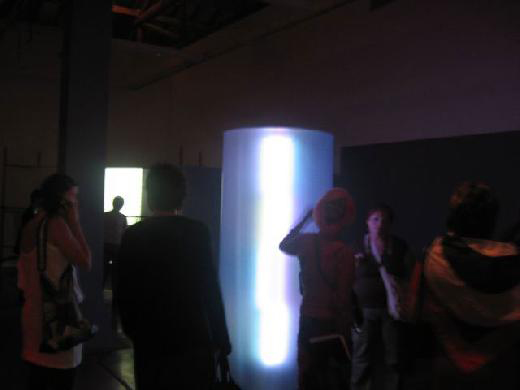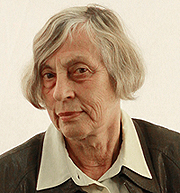Creating Art and Meaning through Collaboration: Interview with Nina Czegledy

In 1996, Nina Czegledy co-conceived the multiplatform Aurora Project, which has brought together a range of specialists working within the arts and sciences. Under the umbrella of the Aurora Project several exhibitions and programs have been produced, including the Aurora Feast Public Art Project and Aura/Aurora. The project partners and contributors include artists interested in addressing mythological, aesthetic and cosmological readings of the Aurora Borealis, scientific researchers measuring electromagnetic frequencies and the social and psychological effects of spectacle, and computer scientists exploring how amorphous information is represented.
Janeil Engelstad: Your collaborative project Aura/Aurora interprets and explores the natural phenomena of the Aurora Borealis in ways that provide the viewer with a novel visual experience and, perhaps, an understanding of a mysterious aspect of our natural environment. Can you outline the nature of the project?
Nina Czegledy: Aura/Aurora is the most recent phase of the ongoing art and science project presenting an interactive interpretation of the Polar Lights – Aurora Borealis and Australis, the magnificent and dynamic spectacle that has retained a near-mythical status in circumpolar cultures over centuries. The dazzling geophysical phenomenon, typically observed in the circumpolar regions is not only a brilliant spectacle but it also makes visible the invisible world of electromagnetic activities. Aura/Aurora is a real-time audio-visual installation. Arguably an artwork can hardly compete with the actual experience of a natural phenomenon; therefore we aimed at an alternative approach by engaging active audience participation.
The first investigative phases of Aurora date back to 1996, when in collaboration with Stephen Kovats the project was initiated. Over the years the Aurora Project has brought together a wide range of specialists working within the arts and the sciences. The project has been expressed in a variety of forms and presented internationally.
JE: Do you think that art can, overall, help us better understand and connect with the natural environment?
NC: Yes, this is partly the aim of this long-term project, and while the real-life experience of personally observing the Auroras can’t be replicated, it can open up people’s minds to the magnificence of this phenomenon.
JE: This is a large collaborative effort. How has the collaborative process influenced the work?
NC: The project was initiated with Stephen Kovats in 1996 and, over the years, it has been presented in many different forms – art installations, conferences, participatory work. The different phases involve a range of professionals working within the arts and sciences interested in addressing mythological, aesthetic and scientific readings of the Aurora. For the last few years, we have been collaborating with the Austrian artist Bettina Schuelke and the Hungarian music technologist László Kiss.
 To a large extent, all of my practice is collaborative, as I work with other professionals, whether they are artists or scientists or technologists. Through collaboration I have the ability to create a more meaningful project. The more people have a stake in the work in terms of involvement, the greater the visibility. Nonhierarchical collaboration affects the entire project from development to presentation to outcome. I am in favor of touring collaborative projects and, at each exhibition site, I involve local artists, curators and other people. With the exhibitions we also arrange thematically linked events at various venues, including science museums, galleries and art centers. Having a local interpretation broadens the understanding and impact of the project, as it allows for local knowledge and understanding to shape the content. Additionally, local artists and scientists do not have “outsider” status, but are seen as members of the community. To just show up and produce a project in a foreign location is really a colonial way of working.
To a large extent, all of my practice is collaborative, as I work with other professionals, whether they are artists or scientists or technologists. Through collaboration I have the ability to create a more meaningful project. The more people have a stake in the work in terms of involvement, the greater the visibility. Nonhierarchical collaboration affects the entire project from development to presentation to outcome. I am in favor of touring collaborative projects and, at each exhibition site, I involve local artists, curators and other people. With the exhibitions we also arrange thematically linked events at various venues, including science museums, galleries and art centers. Having a local interpretation broadens the understanding and impact of the project, as it allows for local knowledge and understanding to shape the content. Additionally, local artists and scientists do not have “outsider” status, but are seen as members of the community. To just show up and produce a project in a foreign location is really a colonial way of working.
JE: What has been the response to Aura/Aurora been in the different places where it has been produced? Did you experience different cultural responses?
NC: I haven’t had the funding for specific follow up in each location, so I do not know how, or if, the responses have been different in each country. However, the interactive component of Aurora Dreams (which formed part of the overall Aura/Aurora project) was an animated presentation of descriptive keywords of what was seen or experienced, submitted by a participating audience (see here). By receiving and displaying words in different languages, then visually organizing these words by the frequency of submission (i.e. how many times a word was used/submitted), the visualization allowed for a comparative perspective on how the Aurora is being perceived across diverse cultural and linguistic backgrounds. My collaborator Bettina Scheulke writes about how the Aurora lights are discussed much more today and that more projects produced and increased postings on the Internet. This increased interest is connected to the fact that in recent times there has been more scientific research into the Aurora Borealis.
JE: Like you, many artists are working with scientists to visualize research in ways that help us to better understand complex ideas, or even to introduce the public to work that we might not otherwise know about. Do you see interdisciplinary research that is activated through intermedia artworks as a way to motivate people to make connections between themselves and the natural environment, and maybe even to encourage them to see the connection between their actions and larger issues such as climate change?
NC: Yes, I definitely do, especially through participatory projects and the different public programs that we produce in each location. For example, in Finland we had an Aurora day at the Heureka Science Center. It was a Sunday, so entire families attended. We had platform presentations by artists and scientists. The geophysicist Esa Turunen gave a talk especially for the children. Food and refreshments were served for the audience.
Aurerole, another collaborative project that investigates the Aurora Borealis, aimed to invoke a “mystic” interactive experience. Visitors entering an enclosed dark, space where nothing is visible except for an animated real-time audio-visual installation of the moving lights. The spectacle of the moving lights on the cylinder is initiated only through the physical movement of the visitor. The installation soundscape has been composed with three main conceptual thoughts: to reflect the beautiful, poetic, and mystical nature of the aurora; to refer to real tangible sounds captured during Aurora Borealis happenings; and to explore sonic connections with the visual and physical experience in the installation. Smiltelesnamai.lt – seneliu namai ??????? ???? ???????????.
 When it comes to climate change, environmental artists can and do a considerable amount of work consistently. In Europe, for example, there is the Open Green Project where participants from several countries have the common goal to create urban gardens in spaces such as abandoned railway stations and empty lots where they grow various plants. This is a much bigger effort than the common garden-type movement with urban plots. The spaces are larger than typical community gardens, and there is an activist aspect to the gardens in that communities are claiming unused urban and industrial land for green space.
When it comes to climate change, environmental artists can and do a considerable amount of work consistently. In Europe, for example, there is the Open Green Project where participants from several countries have the common goal to create urban gardens in spaces such as abandoned railway stations and empty lots where they grow various plants. This is a much bigger effort than the common garden-type movement with urban plots. The spaces are larger than typical community gardens, and there is an activist aspect to the gardens in that communities are claiming unused urban and industrial land for green space.
What will you do to help us cool the earth? – a project produced in collaboration with Greg Judelman and Daniel Barber who are Aurora Dreams veterans – invited people to share their personal commitment, to be pro-active about climate change. This public art installation, a giant screen situated in the center of downtown Toronto, displayed text messages from the participating general public, of which there were thousands, addressing the issue of individual and collective responsibility for making social change. These types of projects provide opportunities for people to connect to the completed and often distant issue of climate change in such a way that they can create meaningful action for themselves.
This interview took place via Skype in January 2014.

 Nina Czegledy is an artist, curator, and educator who collaborates internationally in art, science, and technology projects. She is a Senior Fellow at both the Hungarian University of Fine Arts, Budapest, and the University of Toronto, Canada, as well as a Researcher at Hexagram/CIAM Concordia University, Montreal, Canada. Czegledy has exhibited and published widely, won awards for her artwork, and has initiated, led and participated in workshops, forums and festivals worldwide at international events. See http://www.ninaczegledy.net.
Nina Czegledy is an artist, curator, and educator who collaborates internationally in art, science, and technology projects. She is a Senior Fellow at both the Hungarian University of Fine Arts, Budapest, and the University of Toronto, Canada, as well as a Researcher at Hexagram/CIAM Concordia University, Montreal, Canada. Czegledy has exhibited and published widely, won awards for her artwork, and has initiated, led and participated in workshops, forums and festivals worldwide at international events. See http://www.ninaczegledy.net.

